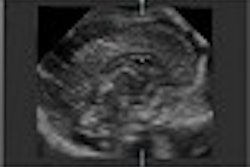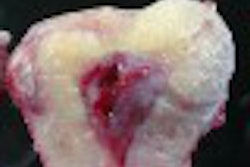(Ultrasound Review) Patients with active rheumatoid arthritis (RA) were treated with tumor necrosis factor alpha blockade in order to evaluate the effects on pannus formation and neovascularization, in a study recently published in Annals of Rheumatoid Disease.
Using high-resolution ultrasound and color Doppler, a quantitative analysis of vascularity was made using the second metacarpophalangeal (MCP) joint of the right hand. Transverse and longitudinal images were digitally stored, and analyzed with specialized software used to assess vessel count within a user-defined region of interest (ROI).
The five patients studied all had active erosive disease at the wrist and at multiple joints of both hands. Treatment with etanercept was for one month, and no intra-articular corticosteroids were administered during that time.
Four methods of treatment evaluation were used. Ultrasound assessment of pannus vascularity was performed before, during, and after treatment, as was clinical course, subjective pain score, and blood chemistry analysis.
Using a high-frequency linear transducer (13-5 MHz), longitudinal and transverse images were obtained from the dorsal aspect with the joint flexed 20º. "Intra-articular color density was quantified in the longitudinal and transverse views within a user-defined ROI by computer-aided image analysis," the authors said. The sum of all color pixels in both longitudinal and transverse scans of the second MCP joint was calculated and called the pannus vessel index.
Clinical improvement and a significant reduction in pain score and in C reactive protein were demonstrated. Color Doppler showed a reduction in pannus vessel index. "Pearson’s correlation coefficient between the results obtained by high-resolution ultrasound and the clinical response was 0.85," the researchers noted. In three of five patients, treatment with corticosteroids could be reduced during the month-long treatment and evaluation.
MRI also has been used to monitor treatment in RA patients, but the authors recommend using ultrasound because it is less expensive, more mobile, and more widely available. Early treatment evaluation means that immunosuppressive treatment might be modified, thus preventing further articular damage.
According to Dr Hau and colleagues, "high-resolution ultrasound is promising as an additional useful method in the assessment of rheumatoid arthritis activity, and probably also in monitoring therapeutic responses."
"High-resolution ultrasound detects a decrease in pannus vascularization of small finger joints in patients with rheumatoid arthritis receiving treatment with soluble tumor necrosis factor a receptor (etanercept)"
M Hau et al
Bismarckstrasse 24, 97209 Veitshöchheim, Germany [email protected]
Ann Rheum Dis 2002 (January); 61:55–58
By Ultrasound Review
February 8, 2002
Copyright © 2002 AuntMinnie.com



















